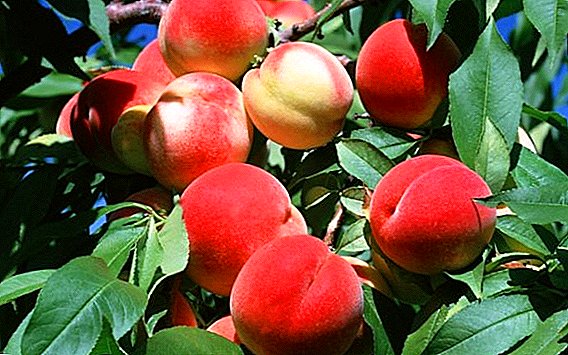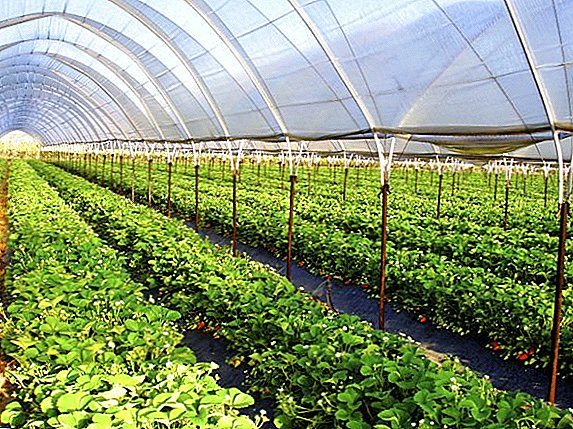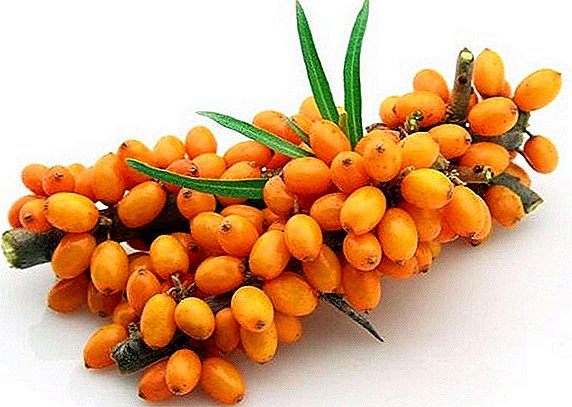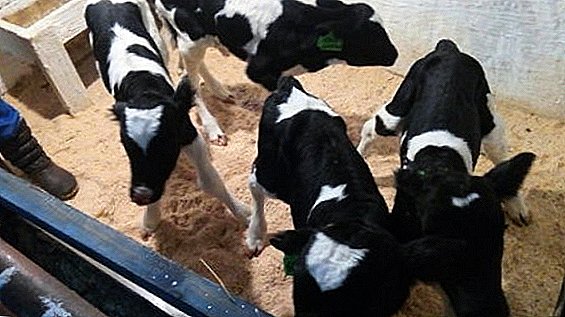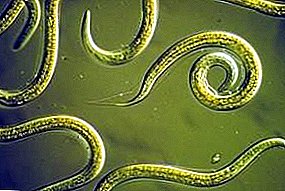
Cultivated plants grown as decorative or food in country houses and kitchen gardensare constantly being attacked by pests.
These are numerous animals, birds, insects and ... parasites.
Nematodes - extensive group of parasites, causing significant damage to growing plants, settling on their leaves, stems and even roots.
In this article we will look at some types of nematodes capable of harm crop plants in your garden or garden.
What parasites look like what threat do they carry to plants and man, and most importantly - how to recognize this or that type of pest? Let's try to deal with the characteristic features of each nematode, so that the fight against them will be the most successful.
Golden Potato Nematode
This type of parasite exclusively on plants from family solanaceous, able to affect the roots of tomatoes and potatoes. Potato nematode - what is it?
Golden Potato Nematode - Photo:

Sizes of Golden Nematode on Potatoes incredibly small and indistinguishable to the human eye. When viewed through a microscope, you can find that it is a worm up to 2 mm in length, having a rounded shape and a golden or brown color.
Infection of the plant roots occurs after the parasite is attached to it, which injects it into the root cells. special secretsplitting the entire contents of living cells. Then, the cells, thus softened, are absorbed by the nematode.
Potato nematode signs: the main signs of infection are, above all, bottom leaves - they turn yellow and dry. Almost immediately, the number of stalks near the bushes on potatoes is noticeably reduced - some of them wither, the rest do not grow to normal sizedying in the early stages. Tubers and flowers are also not formed, or are formed too small. All this is due to the violation of the flow of water and minerals through affected roots.
They can accidentally carried together with the remains of diseased plants, as well as with lumps of earth, tools, rainwater and wind. Golden potato nematode - is there a danger to humans?
To eradicate the nematode quite difficult, when grown in contaminated soil, it can cause serious damage to the crop, for example, to cause such diseases of potatoes as globoderosis (short stature of plants, deformed leaves, deformed root system with growths). However, for a man she absolutely harmless.
You will learn about the danger to the harvest of the golden potato nematode from the video:
Stem
There are several varieties of stem nematode, each species is able to parasitize only on one type of plant. Such nematodes are dangerous for onions, garlic and potatoes, as well as flower plants such as tulips, phloxes, carnations, begonias and some other plants.
The dimensions of the stem nematodes do not exceed 1.7 mm, the shape of the body is filiform. Stem nematode - photo:

Most often, infection occurs. through damaged root sites plants, less often through the skin. Once inside, nematodes begin to multiply rapidly, laying eggs.
Most faithful sign of infection in onions or garlic, is the condition of the cover. If the bulbs suddenly formed a bright white spot on the scales, which then swelled and became loose, then this is the site of active reproduction of the parasites.
If we consider the stems, we can notice characteristic thickenings and swellings, leaves and flowers are also crooked. In the most severe cases of infection, the plant dries and dies.
Understand that the reason is in the stem nematode, you can also on the color of the affected areas: they become pale in color, which eventually turns brown. This indicates destruction and dying off of stem cells.
Nematode stem cysts are less resistant than root cysts - they remain in the soil up to 5 years and are sensitive to high temperatures, so to prevent spread, infected plants are better to burn, although there are more benign methods.
Stem nematode causes ditilenhoz, which is manifested in the deformation of the leaves, as well as damage to the tubers, on which characteristic gray spots are formed. Despite the devastating effect of this parasite on plants, cases human infection has not been established. However, chemicals used in the fight against this pest are more dangerous.
Leafy
it the smallest representatives among all plant nematodes. Sheet nematode has no color, and body length does not exceed 1 mm.
Sheet nematode - photo:

These parasites have the ability to very fast moving inside the plant and can tolerate viral diseases, such as the virus kurshavosti and the virus ring spot of tomato.
Nematodes parasitize on the leaves of many plants, but chrysanthemum, strawberries and tomatoes are particularly common.
The disease process is immediately reflected on the leaves in the form dry spots of irregular shapedisarrayed. Sometimes these spots have a yellow or brown color. Next comes the thinning and wilting of the leaves.
Unlike other species of nematodes, leaf chooses dry leaves as a shelter, less often soil. It can spread first of all due to careless contact with an infected plant, because up to 15 thousand microscopic specimens can live and develop on it. Nematode cysts are also found in the soil in winter, therefore important to work the land before landing.
Leaf nematode very dangerous for greenhouse and garden plants. It is capable of parasitizing not only in the leaves, but also affects the stems and even flowers, leading to the death of the plant organism. Unfortunately, to cure such a plant without harming oneself is almost impossible.
What is the harm to humans? AT human body leaf nematodes do not survive, however inadvertent use in large quantities can lead to easy poisoning due to the toxic metabolic products secreted by the parasite into the plant tissue.
Gallic root
Parasite on plant roots vegetable crops. Interestingly, the females of these nematodes lead an immovable lifestyle, whereas the males are larger and have activity to move.
The root nematode is a parasite. The length of the body of these parasites does not exceed 2 mm, in the early stages of development they have a whitish color, which with age grows pale and becomes transparent. That is why the fight against the gall nematode is considered one of the most difficult: independently, without the aid of a microscope, nematodes are difficult to distinguish from other root cells.
Gallic root nematode - photo:

The big danger is parasite penetration: the gall nematode does not need open wounds on the plant, it pierces with a sharp needle located in the oral opening, the cells, after which it penetrates into the tissues and settles into them. Plant exposed destructive toxins the parasite.
Shoots of plants are experiencing lack of water, and therefore begin to lag in growth and die.
When inspecting the root system, it is not necessary at the sight of blisters to immediately destroy the plant. Sometimes galls can appear from quite harmless symbiotic organisms, for example, nodule bacteria. It is best to give part of the root for examination.
Gallic nematode spreads first with soil, soil and sandIt is also possible direct infection through contact of root systems during transplantation.
Most plants die from the action of this parasite, but cabbage, garlic and cereals resistant to nematode. The gall nematode is capable of causing melodogenesis, accompanied by yellowing and wilting of the leaves, by slow growth of the plant.
There are some safe methods of struggle with the nematode, moreover, due to the narrow specialization of parasitism, the gall nematode does not penetrate higher than the roots, and therefore the probability of getting into the human body is minimal.
How to recognize the root nematode, you will learn by watching this video:
As you can see, even the smallest pest is able to inflict more damage to the plantthan ordinary birds and rodents, attacking the plant imperceptibly and slowly bringing it closer to death. Fight him very difficultHowever, based on the above symptoms and characteristics, you can try to limit its spread to other healthy plants.


